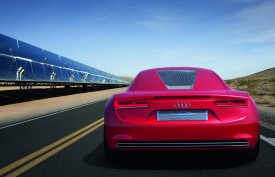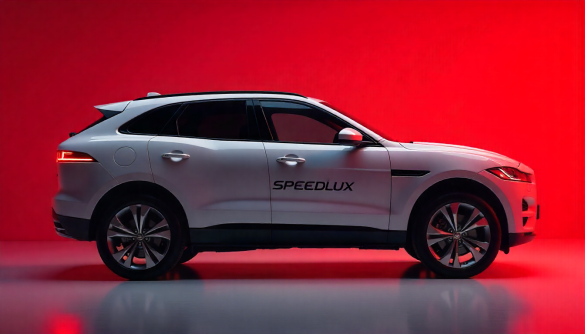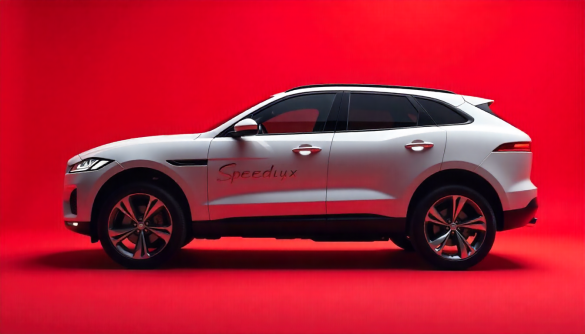 Tesla Motors has already proved that sports car can be fully electric. Mercedes is working on an electric SLS and now Audi is joining the crowd with R8-based all electric e-tron.
Tesla Motors has already proved that sports car can be fully electric. Mercedes is working on an electric SLS and now Audi is joining the crowd with R8-based all electric e-tron.
The e-tron uses four electric motors(two at each axles) making it a true quattro.
When combined these engines produce 313 horsepower and unbelievable 4,500 Nm (3,319.03 lb-ft) of torque. 0-100 km/h (0 – 62 mph) comes in 4.8 seconds, 60-120 km/h (37 – 74 mph) in 4.1 seconds.
Power is stored in a 53 kWh lithium-ion battery pack mounted ahead of the rear axle weighing 470 kg (1,036 pounds). Total weight of the car is 1600 kg (3,527 pounds) and estimated range is 248 km (154 miles).
Press release:
Frankfurt Motor Show (IAA) 2009
The Audi e-tron
Audi presents the highlight of the IAA 2009: the e-tron, a high-performance sports car with a purely electric drive system. Four motors – two each at the front and rear axles – drive the wheels, making the concept car a true quattro. Producing 230 kW (313 hp) and 4,500 Nm (3,319.03 lb-ft) of torque, the two-seater accelerates from 0 to 100 km/h (0 – 62.14 mph) in 4.8 seconds, and from 60 to 120 km/h (37.28 – 74.56 mph) in 4.1 seconds. The lithium-ion battery provides a truly useable energy content of 42.4 kilowatt hours to enable a range of approximately 248 kilometers.
The performance figures are by no means the only evidence of the consistent and holistic strategy. The design makes it clear that the e-tron belongs in the major leagues of sports cars, and the package takes into account the specific realities of an electric vehicle. The battery is directly behind the passenger cabin for an optimal center of gravity and axle load distribution.
The e-tron is able to freely distribute the powerful torque of its four electric motors to the wheels as required. This so-called torque vectoring allows for dazzling dynamics and an undreamed-of level of agility and precision when cornering.
Audi has taken a new and in some cases revolutionary approach to many of the technical modules. A heat pump is used to efficiently warm up and heat the interior. The drive system, the power electronics and the battery are controlled by an innovative thermal management system that is a crucial component for achieving the car’s range without compromising its high level of interior comfort. Networking the vehicle electronics with the surroundings, which is referred to as car-to-x communication, opens new dimensions for the optimization of efficiency, safety and convenience.
The Concept
Electric drive systems are still very much outsiders. The first vehicles of this type took to the roads around 1900, yet in 2009 no volume car manufacturer has a car powered exclusively by batteries in its lineup. Fewer than 1,500 electric vehicles are currently registered in Germany, corresponding to only 0.035 percent of all registered vehicles.
Yet electric driving potentially offers numerous advantages. Electric cars reduce the dependence of transportation and the economy on the raw material petroleum. They produce no direct exhaust emissions and thus ease the local burden on the environment. Electric drive systems are also significantly more efficient than combustion engines, consequently making them easier on the customers’ wallets. Other strengths include sportiness and the fun they bring to driving. All of the torque is essentially available the moment the driver steps on the accelerator, allowing for breathtaking acceleration.
There is still a lot of work to do before electric cars are ready for volume production, however. The greatest challenge is the integration of the energy storage system. Acceptable range and performance requires a traction battery that is heavy and takes up a lot of space. Audi is taking a new approach to offset these disadvantages – a holistic approach with a specific vehicle package, a systematic lightweight construction concept and an optimal configuration of all components for the electric drive.
Audi e-tron – The Holistic Approach
The most important development related to batteries for electric drives are lithium-ion cells. Numerous experts throughout the world are working on their further development for use in cars, with the primary objectives being to reduce weight and increase capacity and performance. Audi has also opted for this technology, both for use in a hybrid production vehicle, such as the upcoming Q5 hybrid, and in the e-tron test platform.
The requirement specification for the concept vehicle goes far beyond battery technology and the replacement of the combustion engine with an electric drive system, however. The Audi development engineers decided back in the concept phase to design practically every component and technology based on the new requirements of electric mobility. The interaction of all elements has a decisive influence on the factors efficiency, range and practicality.
The Audi team therefore focused its attention on the total vehicle, which is reflected in the comprehensive requirement specification.
– The reduction of road resistances and the resulting increase in range plays a major role with electric vehicles. Lightweight construction was therefore a top priority for the e-tron concept car. The body, in particular, combines low weight with supreme strength and rigidity. An intelligent aerodynamics concept with active elements helps to reduce consumption.
The package ensures the safe integration of the electric drive system and the battery. Placing the battery in front of the rear axle ensures an optimal axle load distribution without compromising the compact overall design and the generous amount of interior space.
Advanced battery technology enables a practical range. The battery system is water-cooled for optimal performance and service life.
A needs-based energy management system controls all functions for the chassis, convenience equipment and other auxiliary consumers.
The innovative thermal management system with optimally matched cooling and heating components considers the cooling requirements of the battery and the drive system in addition to the interior temperature.
Driving dynamics and road comfort are what Audi customers have come to expect in the sports car segment.
– Vehicle safety is on par with the best of today’s production vehicles.
The driver is provided with clear and comprehensive information.
The e-tron concept car uses car-to-x communication technology developed by Audi to improve the efficiency of conventionally powered vehicles. For example, information about traffic light cycle times and the flow of traffic – provided by the infrastructure and other vehicles – is used to compute an optimal driving strategy. Audi has already modeled such a solution in Ingolstadt as part of its “travolution” project.
Design and Package
The caliber of the car is apparent to the observer at first glance. The Audi e-tron has a wide, powerful stance on the road. The car body seems almost monolithic; the closed rear end appears powerful and muscular. The trapeze of the single-frame grille dominates the front end and is flanked by two large air intakes. The top of the grille merges into the flat strips of the adaptive matrix beam headlamp modules with their clear glass covers. High-efficiency LED technology is used for all lighting units – a matter of honor for Audi as the worldwide pioneer in this field.
The headlamps are the core of a fully automatic light assistance system that reacts flexibly to any situation. The new technology recognizes weather conditions and adapts the illumination to rain or fog. The technology at the heart of the light assistance system is a camera that works together with a fast computer to detect oncoming traffic, recognize lanes and measure visibilities, such as in the event of fog.
If there is oncoming traffic, for example, the high beams are turned off in the corresponding section of the illumination field. The cornering light system analyzes data from the navigation system and illuminates corners before the driver steers into them. The Audi e-tron does not have conventional fog lamps that consume additional power. It instead intelligently varies the low beams to widen the illumination field, thus significantly reducing the glare from the car’s own lights.
The variability of the headlamps is also reflected in their design. The LED elements change appearance and thus the character of the front end of the vehicle depending on the speed driven and the ambient conditions. The innovative lighting technology offers the Audi designers almost as much design freedom as the shape of the body does.
A new design element unique to the e-tron are the air intakes in the single-frame grille and in front of the rear wheel wells. They are closed flush under normal circumstances and opened by means of flaps when additional cooling air is required. Maximum efficiency is also the reason behind this measure. The concept car has a remarkably low drag coefficient, which gets even better when the flaps are closed.
The vehicle body is compact. The sweeping line of the front end and the flat curved roof immediately identify the two-seater as an Audi. The contours of the flanks are familiar. The tapering of the dynamic line above the sill and the shoulder line tie together the front end, the side and the rear, lend a plastic quality to the doors and the transition to the side air intake and sharply emphasize the Audi-typical round wheel wells with the large, 19-inch tires.
1.90 meters (74.80 in) wide, just 4.26 meters (167.72 in) long and 1.23 meters (48.43 in) tall – those are the proportions of a supercar. The wheelbase of 2.60 meters (102.36 in) leaves plenty of room between the axles for people and technology. Like with a mid-engined sports car, the cabin of the e-tron is shifted far forward toward the front axle, leaving room in front of the rear axle for the roughly 470 kilogram (1036.17 lb) battery unit, the inverter and the power electronics.
The two electric motors, which have their own cooling system, are mounted behind the rear axle. The front electric motors are mounted on the front axle, with their cooling system arranged in front of them. This special package, which features a 42:58 weight distribution, ensures perfect balance, which contributes to the driving dynamics of the e-tron.
Systematic lightweight construction is an even more important prerequisite for efficiency and range with electric vehicles than for conventionally powered automobiles. The Audi development engineers drew on the core competence of the company for the e-tron. The body structure is based on Audi Space Frame (ASF) technology and was realized as a hybrid construction. All add-on parts – doors, covers, sidewalls and roof – are made of a fiber-reinforced plastic.
The combination of aluminum and carbon fiber-reinforced composite material guarantees supreme rigidity coupled with low weight. Audi will soon use this technology in a similar form for production vehicles. Despite the complex drive system layout with four electric motors and a high-capacity battery system, the total weight of the Audi e-tron is only around 1,600 kilograms (3527.40 lb).
Interior and Control Concept
Optical and functional references to the new drive concept characterize the interior design. They establish an advanced connection between proven Audi genes and new formal hallmarks. Typical for the Audi design language is the reduction of the architecture, controls and flow of information to the essential in favor of visible lightweight construction and a tidy overall impression.
The dash appears to float and has a curve that extends laterally into the door panels. With no need to allow for a transmission, shifter and cardan tunnel, the designers took advantage of the opportunity to create a particularly slim and lightweight center tunnel and center console. The flush gear selector, with which the driver chooses between the modes forward, reverse and neutral, emerges from the tunnel when the vehicle is started.
The cockpit of the e-tron is also oriented toward the driver – a further characteristic Audi trait. Instead of the classic instrument cluster, the concept car is the first Audi to be equipped with a large, fold-out central display with integrated MMI functions. It is flanked by two round dials.
The MMI is controlled via a scroll pad with a touch-sensitive surface on the steering wheel (“MMI touch”) – an element inspired by modern smartphones.
While an analog speedometer on the right provides speed information, the instrument on the left tells the driver how much power is being drawn. The central display shows the range in the status bar and presents all key information from the infotainment and navigation systems. It also provides the driver with relevant data from the vehicle’s communication with its surroundings. The instruments combine the analog and the digital worlds into a single unit.
Characteristic for the concept of the Audi e-tron is the near total elimination of switches and small components such as the ignition. The climate control unit is located to the right above the steering wheel. The display provides temperature and ventilation information. Again drawing inspiration from a smartphone, the system is controlled by means of a touch-sensitive sliding control.
The racing-inspired lightweight bucket seats combine excellent lateral support with comfort. To contrasting colors – snow white and cognac – delineate the various zones of the interior. The colors and the high-quality materials combine elegance and sportiness.
Drive System and Energy Supply
Four asynchronous motors with a total output of 230 kilowatts (313 hp) give the Audi e-tron the performance of a high-output sports car. The concept car can accelerate from 0 to 100 km/h (0 – 62.14 mph) in 4.8 seconds if necessary, and goes from 60 to 120 km/h (37.28 – 74.56 mph) in 4.1 seconds. The torque flows selectively to the wheels based on the driving situation and the condition of the road surface, resulting in outstanding traction and handling.
The top speed is limited to 200 km/h (124.27 mph), as the amount of energy required by the electric motors increases disproportionately to speed. The range in the NECD combined cycle is approximately 248 kilometers (154 miles). This good value is made possible by the integrated concept: technology specially configured for the electric drive system combined with state-of-the-art battery technology. The battery block has a total energy content of roughly 53 kilowatt hours, with the usable portion thereof restricted to 42.4 kWh in the interest of service life. Audi uses liquid cooling for the batteries.
The energy storage unit is charged with household current (230 volts, 16 amperes) via a cable and a plug. The socket is behind a cover at the back of the car. With the battery fully discharged, the charging time is between 6 and 8 hours. A high voltage (400 volts, 63 amperes) reduces this to just around 2.5 hours. The Audi engineers are working on a wireless solution to make charging more convenient. The inductive charging station, which can be placed in the garage at home or also in special parking garages, is activated automatically when the vehicle is docked. Such technology is already used today in a similar form to charge electric toothbrushes.
The battery is charged not only when the car is stationary, but also when it is in motion. The keyword here is recuperation. This form of energy recovery and return to the battery is already available today in a number of Audi production models. During braking, the alternator converts the kinetic energy into electrical energy, which it then feeds into the onboard electrical system.
The Audi e-tron, which is slowed by four lightweight ceramic brake discs, takes the next large step into the future. An electronic brake system makes it possible to tap into the recuperation potential of the electric motors. A hydraulic fixed-caliper brake is mounted on the front axle, with two novel electrically-actuated floating-caliper brakes mounted on the rear axle. These floating calipers are actuated not by any mechanical or hydraulic transfer elements, but rather by wire (“brake by wire”). In addition, this eliminates frictional losses due to residual slip when the brakes are not being applied.
This decoupling of the brake pedal enables the e-tron’s electric motors to convert all of the braking energy into electricity and recover it. The electromechanical brake system is only activated if greater deceleration is required. These control actions are unnoticeable to the driver, who feels only a predictable and constant pedal feel as with a hydraulic brake system.
Making its Automotive Debut: The Heat Pump
The heat pump – used here for the first time ever in an automobile – also serves to increase efficiency and range. Unlike a combustion engine, the electric drive system may not produce enough waste heat under all operating conditions to effectively heat the interior. Other electric vehicles are equipped with electric supplemental heaters, which consume a relatively large amount of energy. The heat pump used by Audi – and commonly used in buildings – is a highly efficient machine that uses mechanical work to provide heat with a minimum input of energy.
A high-efficiency climate control system is used to cool the interior. It works together with the thermal management system to also control the temperature of the high-voltage battery. The battery, the power electronics and the electric motors must be kept at their respective ideal operating temperatures to achieve optimal performance and range.
As soon as the vehicle is connected to a charging station the vehicle is preconditioned as appropriate by the thermal management and other associated systems.
The drive system is heated if temperatures are cool, and cooled if hot. This preconditioning can also be extended to the interior, if necessary, so that the passengers can step into a cabin that has been heated or cooled as appropriate for their comfort.
Driving Dynamics
The normal distribution of the tractive power is clearly biased toward the rear axle in accordance with the weight distribution of the e-tron. Similarly to a mid-engined sports car, roughly 70 percent of the power goes the rear and 30 percent to the front. If an axle slips, this balance can be varied by means of the four centrally controlled electric motors. The electric vehicle from Audi thus enjoys all of the advantages of quattro technology.
The four individual motors, which in the interest of greater traction are installed behind the wheels as wheel drives, also enable the e-tron’s lateral dynamics to be intelligently controlled. Similar to what the sport differential does in conventional quattro vehicles, torque vectoring – the targeted acceleration of individual wheels – makes the e-tron even more dynamic while simultaneously enhancing driving safety. Understeer and oversteer can be corrected by not only targeted activation of the brakes, but also by precise increases in power lasting just a few milliseconds. The concept car remains extremely neutral even under great lateral acceleration and hustles through corners as if on the proverbial rails.
The chassis has triangular double wishbones at the front axle and trapezoidal wishbones made of forged aluminum components at the rear axle – a geometry that has proven in motorsports to be the optimal prerequisite for high agility, uncompromising precision and precisely defined self-steering behavior. A taut setup was chosen for the springs and shock absorbers, but it is still very comfortable.
The direct rack-and-pinion steering gives finely differentiated feedback. Its electromechanical steering boost varies with speed, so that the e-tron only has to provide energy while steering, and not while driving straight ahead.
As befitting its status, the Audi concept car rolls on 19-inch tires with a new blade design. 235/35 tires up front and 295/30 tires in the rear provide the necessary grip.
Car-to-x Communication
The electronics development engineers at Audi not only aimed to make the e-tron as efficient and fun to drive as possible, they were also very concerned with safety and traffic management. The technical concept car includes a prototype of an information processing system. Future generations of these systems will usher in a new era in the networking of road traffic, particularly in regions and countries with a high volume of traffic. This progress is made possible by the rapid advancements in computing power, software and communication technology.
The buzzword “car-to-x communication” refers to the direct exchange of information in flowing traffic and to the traffic environment. The letter “x” is a free variable that can refer just as easily to other vehicles as to fixed infrastructure such as traffic lights. In contrast to today’s telematic systems, car-to-x communication no longer requires a central service provider to quickly and effectively pool and process information. The participants themselves perform these tasks by spontaneously networking with one another.
The future car-to-x network still needs some time before it becomes reality on the roads. This obstacle is one that can be overcome, however, as nearly every carmaker in Europe, the U.S.A. and Japan has decided to develop a common standard for hardware and software. Once all new cars are equipped with this technology, a functional network of automotive transmitters will soon be available, at least in large population centers.
These transmitters can be used to open up many new practical applications. Below are just four examples showing the possibilities offered by car-to-x communication.
Example 1 – Efficiency and range: Numerous external factors influence energy consumption and thus the range of any vehicle. An intelligent vehicle equipped with car-to-x technology is aware of necessary braking or acceleration maneuvers in advance because it combines navigational data with information about the flow of traffic, for example. The central computer can prevent driver actions that would use energy unnecessarily or use targeted braking for recuperation of the battery.
Example 2 – Safety: A vehicle has spun out on a slippery road in a blind curve and is unable to free itself under its own power. At the same time, other vehicles are approaching quickly. The stuck vehicle uses car-to-x to send out a warning signal reporting the precise location of the hazardous location. A corresponding warning then appears on the navigation system display of the approaching cars.
Example 3 – Traffic flow: Many cars are traveling between traffic lights on an arterial road. Over and over again, they accelerate only to have to brake again when the traffic light changes to red. Car-to-x technology enables them to establish a network between themselves and receive information from the traffic light controller. The drivers can then make more judicious use of the gas pedal because they know what to expect. The same applies for imminent traffic jams: cars ahead provide information that results in adjustments to the posted speed limits, noticeably spreading out the traffic.
Example 4 – Convenience: The driver has entered a shopping center with a chronic shortage of parking spaces into his navigation system as the destination. With car-to-x, the mobile system networks with the parking space registration system at the destination. When the system in the parking garage reports that a convenient parking spot is available, the navigation system can register its location and also reserve the spot.
The equipment and data specified in this document refer to the model range offered in Germany. Subject to change without notice; errors excepted.







